Combat aircraft. When the horns are not a hindrance
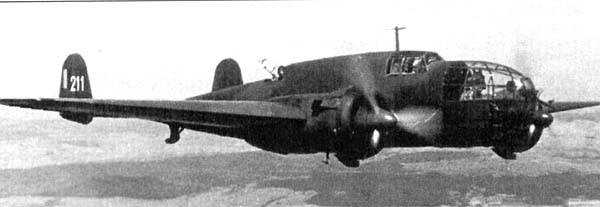
The Polish aircraft industry ... this is usually a reason for smiles. Yes, once there the Poles tried to portray something like that, but since in the First World War there was no Poland yet, and in the Second World War it ended very quickly, then, accordingly, there seems to be nothing to talk about.
However, the Poles built airplanes, and, what is most interesting, they sometimes succeeded. Yes, the balcony-carrying Zubr was not a masterpiece, and the Karas was not perfect, but who can say that the Elk was a bad plane?
Yes, the bomber did not play a significant role in that war, but, excuse me, its peers SB, too, in the Red Army Air Force ended more than quickly.
And as the plane "Los" was not just at the world level, it was a very progressive plane. And it was not his fault that the command of the Polish army gave up so quickly and rushed to flee the country.
So let's take a look at Elk, which was surprisingly quite modern. A monoplane with retractable landing gear, metal covering of the wings and fuselage, closed cockpits - why not a modern aircraft for the second half of the 30s?
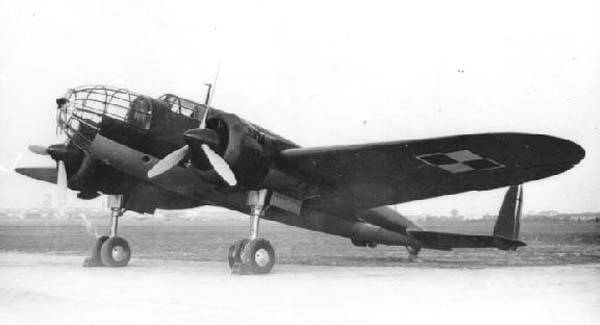
By the time the Second World War began, which began in Europe with the German attack on Poland, everyone who needed it knew firsthand about the Los. The plane managed to visit two aviation exhibitions in Belgrade and Paris. Both "Los" were impressed with their characteristics, and the PZL company was inundated with orders.
Many countries, as expected, wanted to have a bomber in service that flew at a speed of 445 km / h and with a bomb load of 2500 kg. Such a machine made it possible to solve many tasks on the battlefield, especially considering the fact that at that time there were not very many fighters in the world capable of catching up with the Elk.
And in comparison with the former at that time the main bomber of the Polish Air Force, the Dutch licensed version of the Fokker FVIIb-3m, it was generally a masterpiece. And it would be quite logical to replace the old slow three-engined Dutchman with a completely modern aircraft with a bunch of design innovations.
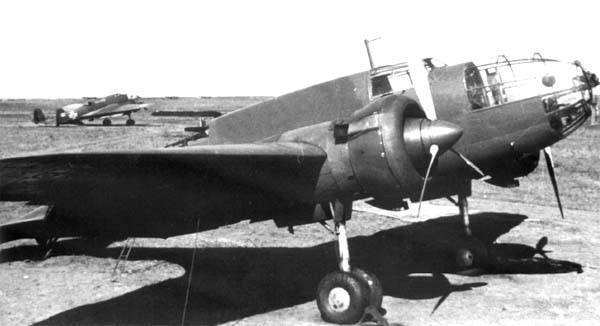
And in the company PZL ("Panstwowe Zaklady Lotnicze") work began to boil.
Work began in the second half of 1934, and in 1936 the first flying prototype was ready. A 9-cylinder air-cooled "star" Bristol "Pegasus" XIIB with a capacity of 860 hp was chosen as the power plant. with. The screws were Hamilcar-Standard. Both engines and propellers were produced in Poland under a British license.
The landing gear struts were retracted back and hydraulically into the niches, the tail speed crutch was also replaced with a non-retractable wheel. The racks were not fully retracted, the wheels protruded from the niches by about half. It was believed that it would be better for a forced landing "on the belly."
The aircraft carried a very decent amount of fuel, which provided a good range. The fuel was housed in two 118-liter tanks located in the engine nacelles, in two 242-liter wing tanks and one 780-liter fuselage tank behind the cockpit.
The crew consisted of three people. The pilot, who is also the crew commander, the navigator-bombardier, whose place was in the nose of the aircraft, which provided aiming and dropping of bombs, and the radio operator, who was located in a separate open cockpit at the trailing edge of the wing.
The radio operator was supposed to defend the upper and lower hemispheres with two 37 mm KW Wz.7,92 machine guns, which were based on Browning models. The machine guns were fed from disks, the stock of cartridges was 1700 pieces.
The bomb bays held 2600 kg. The usual load consisted of 20 bombs weighing 50 or 110 kg, but it was possible to hang 2 bombs of 300 kg and fill the remaining space with small fragmentation bombs of 10 kg.
On July 1, 1936, the first flight of the "Elk" took place. The plane was not devoid of "childhood" illnesses and shortcomings, but the manufacturer promised to fix everything in the shortest possible time. Indeed, the main shortcomings were eliminated and soon the PZL company received an official order for 30 bombers with Pegasus XIIB engines, which, in addition to the P.37A index, received their own name “Los A”.
The cockpits of the pilot and the gunner were expanded, the engines were installed more powerful, "Pegasus" XX with 925 hp, but most importantly, the shape of the tail was changed. Now it has become two-keel. This made it possible to solve two problems at once: to remove unwanted vibrations and to improve the shooter's view. In addition, a fourth crew member was added: an arrow to the ventral machine gun mount. This was very reasonable, one shooter could not simultaneously protect both the upper and lower hemispheres.
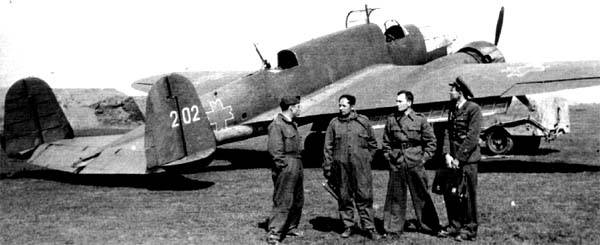
Changed the landing gear: they became two-wheeled, but with a smaller diameter. Now it was possible to sit down safely if one of the wheels was damaged. In addition, since the wheels became of smaller diameter, they were completely retracted into a niche, which had a favorable effect on aerodynamics and gave a speed increase of 6 km / h.
"Los A" actually became the prototype of the production aircraft, which received the index RZ7V "Los B". The plane went into production and by 1939 the Polish Air Force wanted to have 30 Los A units as training and 150 Los B units as the main medium bombers.
In the spring of 1938, the third version of the aircraft was ready, with the French engine Gnome-Rhone 14N, and on its basis it was planned to create export versions "Los S" and "Los D".
In 1938, he began to enter the combat units. The first to go to the troops were "Los A" and "Los A bis". The plane's debut turned out to be discouraging: within two months, 9 planes crashed. The cause was a loss of control caused by rebalancing of the rudder. The steering wheel was changed and the problem was resolved.
"Los" turned out to be a very promising machine, both in terms of use in the Polish Air Force, and in terms of sales to everyone, which turned out to be quite a few. Work on the creation of the export version was carried out constantly, because making money on a successful car is a pleasure. The Polish Air Force wouldn't buy many cars anyway, so why not arm its neighbors too?
Projects of an aircraft with Gnome-Ron engines were considered. "Los S" was planned to be equipped with a G14N01 engine with a capacity of 957 liters. with. The design speed with them could be 460 km / h. "Elk D" with engines "Gnome-Ron" GR 14N21 with a capacity of 1035 hp. with. according to calculations, it could accelerate to a fantastic 490 km / h at that time.
The combat range (calculated) with a bomb load of 2200 kg of these aircraft was, respectively, 1450 and 1600 km. And it could have continued! If we reduce the number of bombs on board to 1760 kg and take an additional supply of fuel into the tank installed in the bomb bay, then the range figures increased to 2600 and 2700 km, respectively.
The prototype P.14 / III was accelerated to a speed of 21 km / h in real-life tests with 37N453 Gnome-Ron motors. An excellent result for that time, considering that in fact the same age as the "Los", the Soviet I-15bis gave out 390 km / h, and the newest German Bf.109В about 460 km / h.
And the shows at the salons, coupled with the test results, did not keep customers waiting long. The first could have been the Spaniards, who ordered 50 Los S planes, but the Spanish Civil War broke out and European countries imposed an arms embargo. The contract was terminated.
But in 1939, the process began.
Yugoslavia has ordered 10 aircraft of the "D" version.
Bulgaria ordered 15 aircraft of the same modification.
Turkey decided to buy 10 aircraft and assemble 15 more on its own, under a license.
Romania wanted 30 aircraft.
Greece has ordered 12 bombers.
In addition, Finland, Belgium, Denmark and Estonia wanted to acquire the assembly license. Since the capacities of Polish factories did not allow the production of "Los" in such quantities, licensed production was welcomed.
It is clear that all plans collapsed on September 1, 1939. And all the treaties burned out in the fire of the outbreak of the war. The only ones who received the Elks were the Romanian Air Force. But these were not the ones ordered by Romania, but Polish planes that flew to the territory of the neighboring country.
But even in Poland itself, everything was not entirely ideal in terms of aircraft production. He clearly lagged behind the schedule, as they say now, "shifted to the right." At the beginning of the war, the units had about 90 combat-ready aircraft.
A small nuance: the "Browning" machine gun KM Wz.37 was not brought to mind, and it was decided to arm the "Elk" with obsolete but mastered machine guns "Vickers F" British design.
When the hostilities began, many aircraft were at various stages of readiness at the factories in Mielec and Warsaw, but the war turned out to be so fleeting that they simply did not have time to finish building them.
By that time, a training unit was formed in the Polish Air Force, where the pilots were trained using the "Los A" and "Los A bis" of the first issues.
The first two days of the war, "Losi" were not involved in combat missions, being in the reserve of the high command. Finally, on September 3, the crews were tasked with attacking Konigsberg. The flight was canceled, and the P.37 made its debut only the next day, September 4, 1939. Three nines "Losyi" made two raids on German units in the Lodz area.
According to the Polish side, the Germans suffered significant damage. In two raids, 7 aircraft were lost, mainly from the actions of the army air defense. The Germans burned two more cars as a result of the attack on the airfield in Kuchiny.
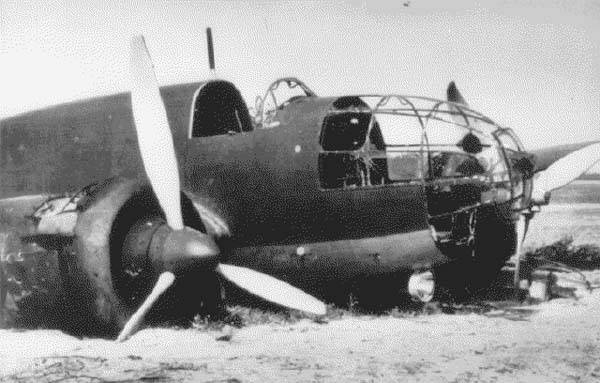
The Poles over and over again made the same mistake that the commanders of the Red Army Air Force will make in less than 2 years: daytime raids without fighter cover. The Messerschmitts were quietly reaping the harvest in the skies of Poland, and the Losi could only oppose the fire of single rifle-caliber machine guns.
So a pair of "Messers" on September 6 calmly shot down three of the six "Elks" flying to bomb the Germans near the city of Radomsko.
"Blitzkrieg" struck not only the Polish units, it also struck the command of the Polish Army, which was poorly guided in the situation and could not really determine the direction of attacking the advancing German units.
In such an environment, Polish pilots continued to fly out with bombs, although it was clear that all this was useless, and everything fell into the chaos of defeat.
The last sorties "Losi" made on September 16, attacking the Germans near Hrubieszow and at Wlodawa.
In total, during that fleeting war, Polish bombers dropped about 150 tons of bombs on the Germans. The shooters shot down six Messerschmitts. Losses on the ground and in the air were 24 aircraft shot down in the air and 2 were lost on the ground. Obviously, such a difference is more than eloquent testimony to the heroism of the Polish pilots, who stubbornly flew out to bomb the Germans without fighter cover. And, frankly, there was no defense of my own.

Two planes ended up in the USSR, they also got there by flight. It is quite natural that the "Elk" was sent to the Air Force Flight Research Institute, where test pilots P.M. Stefanovsky, M.A. Nyukhtikov and AM Khripkov, navigator P.I. Passes. Engineer M.I. Panyushkin.
In the reports of the test team it was said that “P.37 ... is distinguished by good stability in all flight modes and allows flight with completely abandoned manual control at a cruising speed of 270-280 km / h. The piloting technique ... is simpler than that of the DB-3 aircraft and slightly worse than that of the SB. "
The test pilots noted the excellent aerodynamics of the aircraft. It was thanks to her that the "Los" developed a speed equal to the speed of the DB-3 and SB. However, the bomb load of the Polish aircraft was significantly higher than that of the Soviet bombers.
In addition, the entire bomb load of the R.37 was located inside the fuselage and did not spoil the aerodynamics. Yes, "Los" could not take on board bombs over 300 kg. But Soviet bombers, if they carried bombs weighing 500 kg, then on external suspensions. SB carried two, one could be placed in a bomb bay, DB-3 could carry 3 bombs of 500 kg or 1 in 1000 kg on the external sling.
And the suspension of bombs of this weight from the outside clearly entailed a decrease in speed. The only drawback of the R.37 can be considered a low altitude, which was due to the Pegasus motors. But the Pegasus had other strengths.
If we compare the R.37 with the German Ju.88A-1 and Do.215B, which were purchased in Germany in 1940 and studied at the Air Force Research Institute and the Soviet SB, then we can say with confidence that the R.37 was on the same level.
Possessing approximately equal capabilities of defensive weapons, the R-37 surpassed all in terms of bomb load and flight range. The Pegasus motors, although they did not have a high altitude, were extremely tenacious and more reliable than the German liquid-cooled motors.
In fact, the Ju.88A1 had one, but a very significant advantage: the aircraft was able to bomb from a dive, and it did it very accurately. The rest of the "Los" was no worse.
It should be admitted that the "Los" turned out to be a very decent combat vehicle with impressive potential for development.
When Poland surrendered, more than 200 aircraft of the Polish Air Force were at the Romanian airfields. Among this number were 30 R.37, 29 units "Los B" and 1 "Los A". Polish pilots were sent to Iran, to the British mission in the Middle East, and the Romanians, as expected, kept the aircraft for themselves.
The career of "Los" among the Romanians is not that it did not work out, rather, it went as expected. Two squadrons were equipped with aircraft, and the Romanian pilots began to master the new technology. Four Romanian planes were shot in accidents and four more crashed outright during forced landings.
Of course, the planes went to the Romanians with a fairly developed resource, but the "skill" of the Romanian pilots should not be discounted. In general, the Romanian crews of the Losyi considered themselves a “suicide team” for a reason. They did it.
The premiere of Elks for the Romanian Air Force took place on June 22, 1941, when nine R.37s with yellow identification crosses flew to bomb Soviet ships in Odessa.
Did not work out. Three I-153 and fourteen I-15bis of the Black Sea Air Force were raised to intercept Romanian aircraft. fleet... Soviet fighters shot down five Elks, the rest were able to escape. Our pilots had no losses.
In general, the Romanians continued their raids on Odessa, taking advantage of the fact that the Soviet aviation was more than passive, not recovering from the losses of the first days, the effectiveness of the application was below average. The losses of the Romanian Air Force suffered not so much from the actions of the Red Army Air Force or the Air Defense Force, but from the fact that there were no spare parts for the aircraft. Therefore, already in October 1941, all the Losi were recalled back to Romania.
Half of the remaining aircraft were simply dismantled for parts to maintain the other half of the aircraft in combat condition.
The Elks were remembered once again when the Red Army reached the borders of Romania and the case smelled of kerosene. But after several sorties, accompanied by technical problems, the Losi were finally decommissioned and transferred to training units.
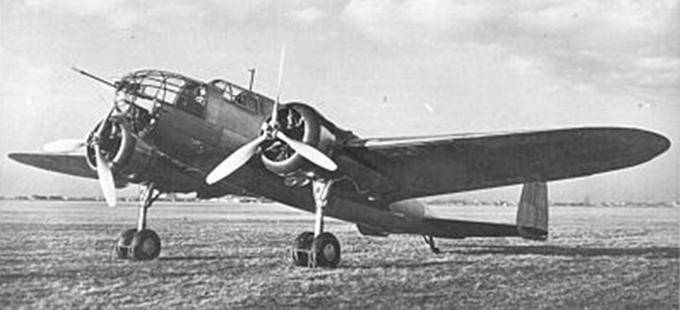
In general, story bomber P.37 "Los" is very sad in its essence. The creation of the designer Jiri Dobrovsky was advanced in 1935, obsolete in 1941 and finally turned into a historical airplane garbage 10 years after the first flight.
Meanwhile, this aircraft for some time even became a reference point for many designers in terms of approach to the principles of creating modern bombers. Its speed qualities and, most importantly, the range and amount of bomb load.
So the R-37 is an aircraft that was a stage in the development of bomber aviation not only in Europe, but also in the world. He could have become a very, very successful aircraft of his time, but he was not lucky. Therefore, its place in history is the best bomber created in Poland.
LTH P-37B
Wingspan, m: 17,93
Length, m: 12,92
Height, m: 5,10
Wing area, sq.m: 53,51
Weight, kg
- empty aircraft: 4 280
- normal takeoff: 8 580
Engines: 2 x Bristol Pegasus XX x 925 HP
Maximum speed km / h: 430
Cruising speed, km / h: 348
Practical range, km
- with maximum load: 1500
- maximum: 2600
Speed, m / min: 285
Practical ceiling, m: 7 000
Crew, prs: 4
Armament: three 7,7 mm machine guns in the bow, dorsal and ventral positions;
Bomb load - up to 3000 kg
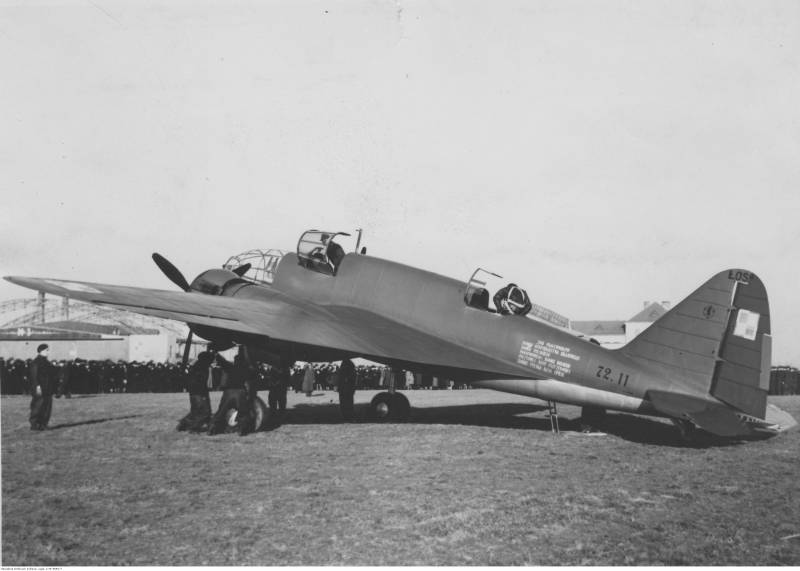
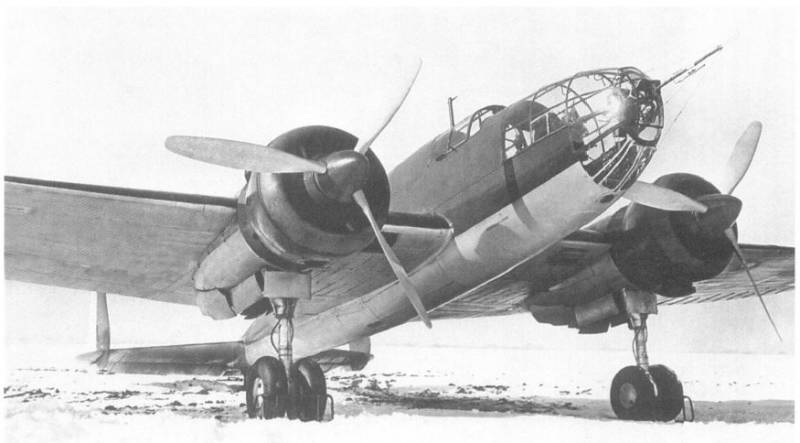
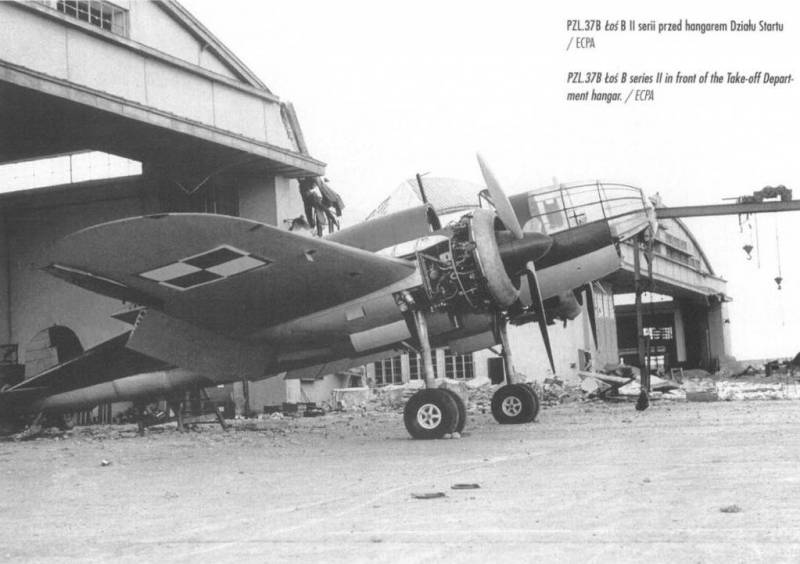
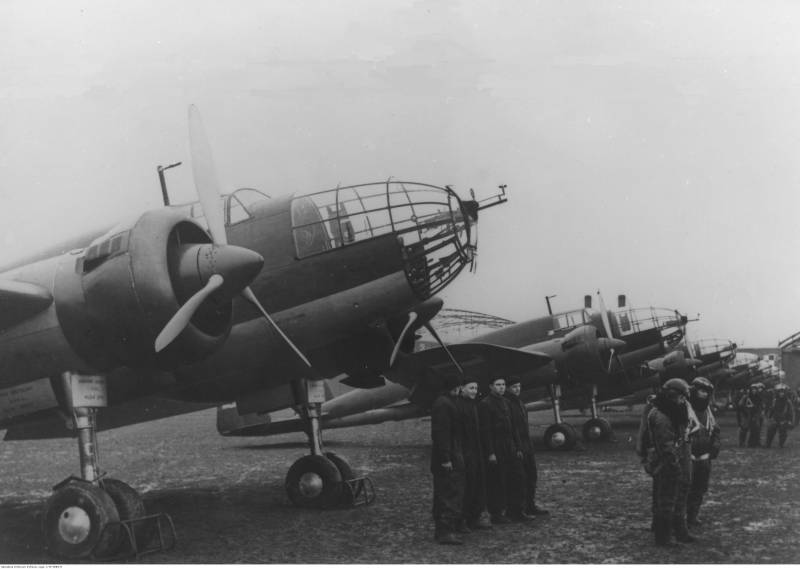
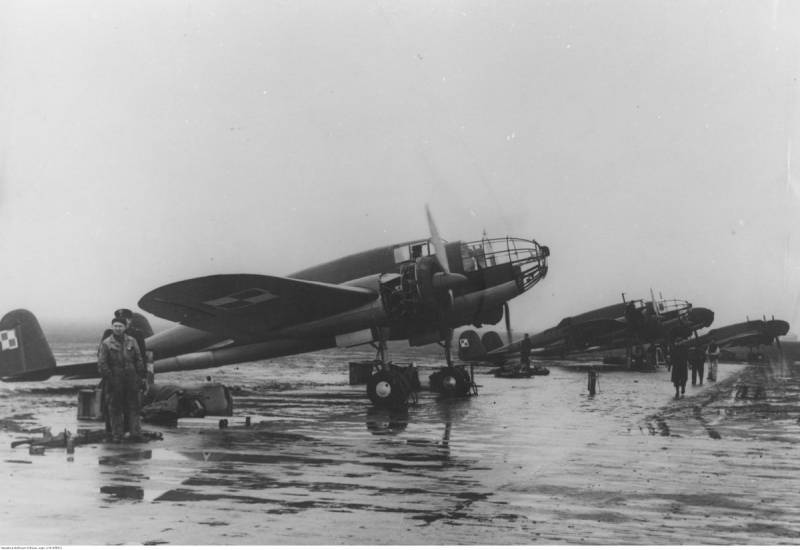
Information